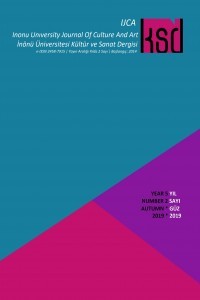MÜZİK TANIMA TEKNOLOJİSİ (MRT) VE ÇEVRİMİÇİ SAĞLAYICILARI
Teknolojinin günümüzdeki kadar gelişim göstermediği zamanlarda radyo veya müzik kanalları aracılığıyla müzikler ve sanatçılar tanıtılırdı. Günümüzde ise ses sinyali işlemedeki gelişimler ve mobil teknolojiler, algoritma işleyicilere müzik tanıma uygulamaları oluşturma fırsatını sundu. Müzik keşfetmenin ve dinlemenin gittikçe basit ve ulaşılabilir olduğu bu noktada dinleyicilerin daha önce duymadıkları ya da beğendikleri müzikleri kolaylıkla bulmaları sağlanmış oldu. Herhangi bir mekanda, radyoda, mağazada duyulan müzikleri bulmak için özellikle akıllı telefonlara yüklenerek daha pratik kullanımı olan bu sağlayıcılar genellikle çevrimiçi kullanıma uygun olarak ücretli ve ücretsiz olmak üzere iki farklı seçenek ile tasarlandı. En çok kullanılan çevrimiçi sağlayıcılardan bazıları şunlardır: Shazam, SoundHound, Musixmatch, MusicID, Soly, Genius. Bu sağlayıcılardan en popüler olanı ise Shazam’ dır. Bu sağlayıcının çalışma prensibine göre bir dinleyici ortamda çalan müziği duyduğunda ve cep telefonunu kullanarak Shazam hizmetini aradığında, çalınan müzikten elde edilen 15 saniyeye kadar ses örneği, ardından parçanın adı ve sanatçısı SMS metin mesajı yoluyla kullanıcıya geri gönderilmektedir. Bu sayede kullanıcı çok hızlı bir şekilde müziğe ulaşıp dilerse ulaştığı müzikleri bir çalma listesine dönüştürebilmekte ve Youtube Music ile şarkının videosunu izlemeye olanak da sağlamaktadır. Spotify, Google Play Müzik ve Apple Music entegrasyonu da mevcuttur. Aynı zamanda çevrimdışı da çalışabilen bu uygulama hafızasına kaydettiği müzikleri internet bağlantısı olduğu anda tanımlayabilmektedir.
Anahtar Kelimeler:
Müzik Tanıma Teknolojisi, Çevrimiçi Sağlayıcı, Algoritma, Music Recognition Technology, Online Provider, Algorithm
MUSIC RECOGNITION TECHNOLOGY (MRT) AND ONLINE PROVIDERS
When technology was not as advanced as it is today, music and artists were promoted through radio or music channels. Today, advances in audio signal processing and mobile technologies have offered algorithm processors the opportunity to create music recognition applications. At this point, where discovering and listening to music has become increasingly simple and accessible, it has been ensured that listeners can easily find music they have not heard or liked before. These providers, which are more practical to use especially by downloading to smart phones, are designed with two different options, paid and free, for online use in order to find the music heard in any place, on the radio, in the store. Some of the most used online providers are: Shazam, SoundHoud, Musixmatch, MusicID, Soly, Genius. The most popular of these providers is Shazam. According to the operating principle of this provider, when a listener hears the music playing in the environment and calls the Shazam service using their mobile phone, up to 15 seconds of sound sample from the music played, then the title and artist of the track are sent back to the user via SMS text message. In this way, the user can reach the music very quickly and turn the music they reach into a playlist, and it also provides the opportunity to watch the video of the song with Youtube Music. Spotify, Google Play Music and Apple Music integration are also available. This application, which can also work offline, can identify the music it saves in its memory as soon as there is an internet connection.
Keywords:
Music Recognition Technology, Online Provider, Algorithm, Music Recognition Technology, Online Provider, Algorithm,
___
- Brinkman, C., Fragkiadakis, M., & Bos, X. (2016). Online music recognition: the Echoprint system.
- Cano, P., Batlle, E., Kalker, T., & Haitsma, J. (2005). A review of audio fingerprinting. Journal of VLSI signal processing systems for signal, image and video technology, 41(3), 271-284.
- Khulcharimah, D. A., Wijaya, A., & Wijaya, S. D. (2017). The Use Of Musixmatch Application And Song To Improve Students'activıiy In Reading English Learning At The First Grade Of Smp Nurul Huda Tulangan Sidoarjo (Doctoral dissertation, Universitas Muhammadiyah Surabaya).
- Lee, D. H., Lim, M. K., & Kim, J. H. (2012). Music Recognition Using Audio Fingerprint: A Survey. Phonetics and Speech Sciences, 4(1), 77-87.
- ISSN: 2458-7915
- Başlangıç: 2014
- Yayıncı: İnönü Üniversitesi
Sayıdaki Diğer Makaleler
MAĞARA RESİMLERİNDEN GÜNÜMÜZE ULAŞAN DIŞAVURUMCU SANAT
BAĞLAMA EĞİTİMİNDE KULLANILAN METOTLARDA PARMAK NUMARALARININ KULLANILMA DURUMU
PABLO PİCASSO VE YEMEK İLİŞKİSİ
ARDAHAN DAMAL YÖRESİ ALEVİ CEMLERİ VE SEMAH RİTÜELİ
Erkan YOLDAŞ, Derya KARABURUN DOĞAN, Şakir Orçun AKGÜN
TÜRK SAZ MUSİKİSİNDE GEÇKİ(MODULASYON)
MÜZİK SANATININ ARGUVAN YÖRESİ GELENEKSEL TÖRENLERİNDE KULLANIMI
YÜKSEK ÖĞRETİMDE TURİZM ÖĞRENCİLERİNİN KÜLTÜRLERARASI DUYARLILIK DERECELERİNİN İNCELENMESİ
K. Dilek TANKIZ, Hasan ARAPGİRLİOĞLU
YÜKSEK ÖĞRETİM KURUMLARINDAKİ ÇAĞDAŞ SANAT EĞİTİMİ MÜFREDATININ YENİ MEDYA SANATINI KAPSAYICILIĞI
